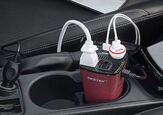Meth Dealers' Worst Nightmare - a Ford That Sniffs Out Drugs (and Gets Great Mileage)

Call it the Ford Narc.
In the near future, police cruisers could detect drug labs just by sniffing the air as they drive down a street, CBC DFW reports (via Autoblog), all thanks to a device built by a team from the University of North Texas.
The highly sensitive mass spectrometer, calibrated in the clean air climes of Antarctica, was installed in the front seat of a Ford Fusion Energi sedan eight months ago.
Originally designed to test air quality, the device — built with the help of Inficon of Syracuse, New York — is now tasked with detecting something much more clandestine than simple smog. Chemicals used in drug making — meth, especially — waft out of houses and apartments whether their owners like it or not, and the device can pinpoint that chemical signature from a quarter-mile away.
“The car could just drive by it and keep moving down the road,” Dr. Guido Verbeck told the CBS affiliate. “It’ll alert the officers there’s something going on at the house, and where the location is.”
Given the sensitive nature of the equipment, it’s easy to see why the team chose a plug-in hybrid for their test vehicle.
A fine-tuned piece of technology is of little use if the operator can’t decipher test results, so the team whipped up software that analyzes the data and tells a police officer exactly what the car is smelling.
“The operator, or the tactical person using it, does not have to know anything about mass spec, they just know that this is bad,” Verbeck said.
As useful a tool as this could be for law enforcement, the test contraption was too bulky for use inside a police cruiser. The team then miniaturized it, so it could fit into a portable case.
Police forces have a habit of spending money on things that make enforcement and crime-solving easier, so the makers (and eventual marketers) of this technology are sitting on a gold mine.

More by Steph Willems
Latest Car Reviews
Read moreLatest Product Reviews
Read moreRecent Comments
- SCE to AUX How well does the rear camera work in the rain and snow?
- MaintenanceCosts The Truth About Isuzu Troopers!
- Jalop1991 MC's silence in this thread is absolutely deafening.
- MaintenanceCosts Spent some time last summer with a slightly older Expedition Max with about 100k miles on the clock, borrowed from a friend for a Colorado mountain trip.It worked pretty well on the trip we used it for. The EcoBoost in this fairly high state of tune has a freight train feeling and just keeps pulling even way up at 12k ft. There is unending space inside; at one point we had six adults, two children, and several people's worth of luggage inside, with room left over. It was comfortable to ride in and well-equipped.But it is huge. My wife refused to drive it because she couldn't get comfortable with the size. I used to be a professional bus driver and it reminded me quite a bit of driving a bus. It was longer than quite a few parking spots. Fortunately, the trip didn't involve anything more urban than Denver suburbs, so the size didn't cause any real problems, but it reminded me that I don't really want such a behemoth as a daily driver.
- Jalop1991 It seems to me this opens GM to start substituting parts and making changes without telling anyone, AND without breaking any agreements with Allison. Or does no one remember Ignitionswitchgate?At the core of the problem is a part in the vehicle's ignition switch that is 1.6 millimeters less "springy" than it should be. Because this part produces weaker tension, ignition keys in the cars may turn off the engine if shaken just the right way...2001: GM detects the defect during pre-production testing of the Saturn Ion.2003: A service technician closes an inquiry into a stalling Saturn Ion after changing the key ring and noticing the problem was fixed.2004: GM recognizes the defect again as the Chevrolet Cobalt replaces the Cavalier.fast forward through the denials, driver deaths, and government bailouts2012: GM identifies four crashes and four corresponding fatalities (all involving 2004 Saturn Ions) along with six other injuries from four other crashes attributable to the defect.Sept. 4, 2012: GM reports August 2012 sales were up 10 percent from the previous year, with Chevrolet passenger car sales up 25 percent.June 2013: A deposition by a Cobalt program engineer says the company made a "business decision not to fix this problem," raising questions of whether GM consciously decided to launch the Cobalt despite knowing of a defect.Dec. 9, 2013: Treasury Secretary Jacob Lew announces the government had sold the last of what was previously a 60 percent stake in GM, ending the bailout. The bailout had cost taxpayers $10 billion on a $49.5 billion investment.End of 2013: GM determines that the faulty ignition switch is to blame for at least 31 crashes and 13 deaths.It took over 10 years for GM to admit fault.And all because an engineer decided to trim a pin by tenths of a millimeter, without testing and without getting anyone else's approval.Fast forward to 2026, and the Allison name is no longer affiliated with the transmissions. You do the math.


































Comments
Join the conversation
Welll, I guess the need to snort meth, is one excuse for a nose like that.....
Is that thing turbo charged?